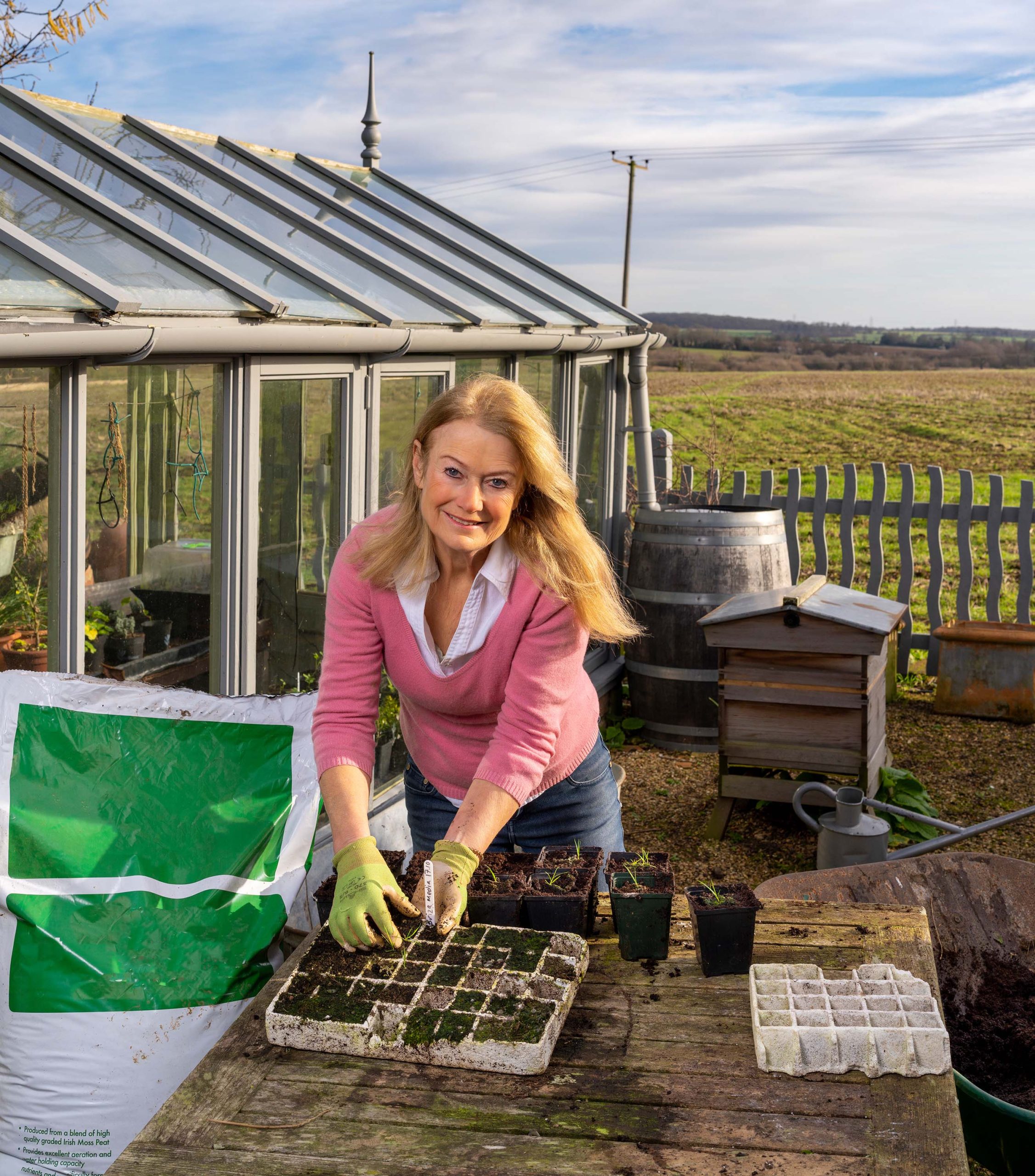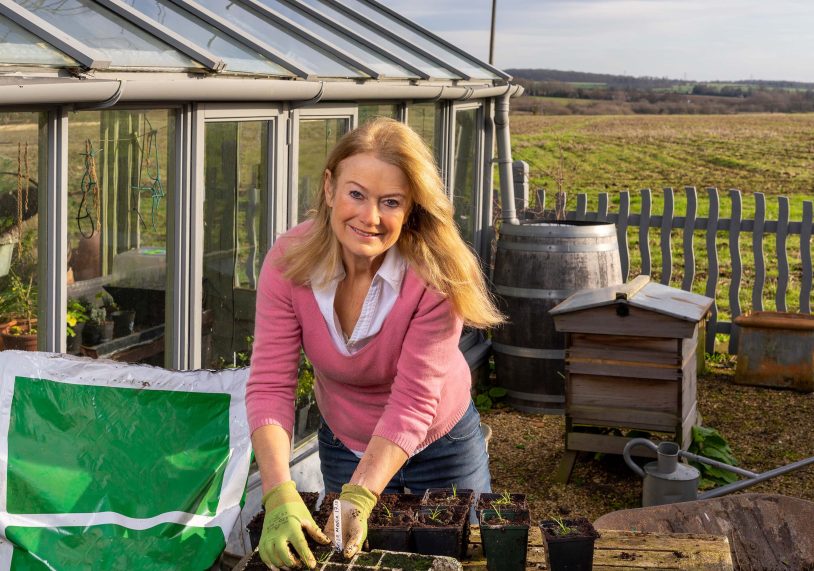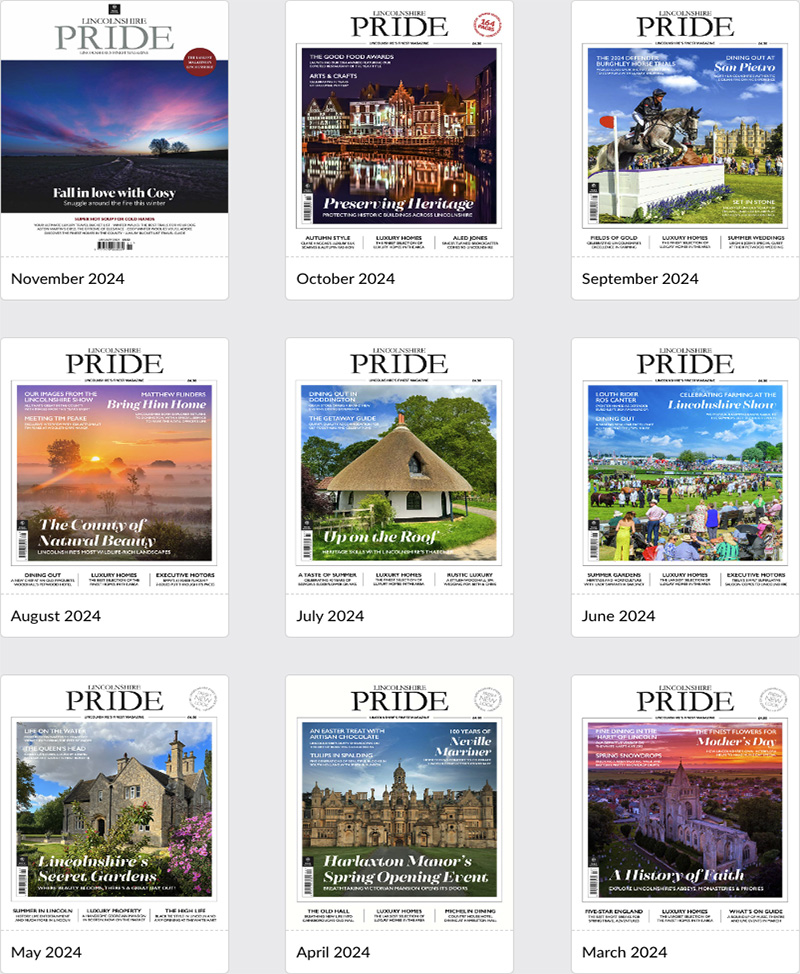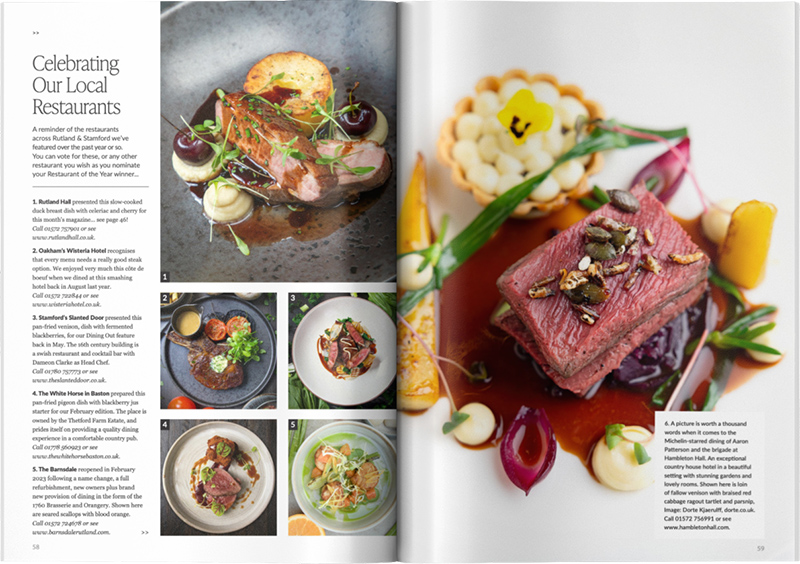
In the Garden with Bunny
Far from being a time to put your feet up, for keen gardeners autumn presents a good opportunity to put the garden to bed, plan for next year and complete all of those pesky jobs you’ve been putting off. An especially well-known gardener is looking forward to getting out in the crisp autumn air, although RHS-winner Bunny Guinness will be taking one evening off, as she invites fellow gardeners to join her for dinner at Rutland’s Hambleton Hall

Far from being a time to put your feet up, for keen gardeners autumn presents a good opportunity to put the garden to bed, plan for next year and complete all of those pesky jobs you’ve been putting off. An especially well-known gardener is looking forward to getting out in the crisp autumn air, although RHS-winner Bunny Guinness will be taking one evening off, as she invites fellow gardeners to join her for dinner at Rutland’s Hambleton Hall
Bunny Guinness’s garden isn’t the only thing that’s growing. Her online presence has also enjoyed a steady increase and today Bunny is as much a broadcaster and journalist on the subject of gardening as she is one of the country’s most sought-after and knowledgeable horticultural experts and landscape architects.
Beyond her regular presence as one of the experts on BBC Radio 4’s venerable Gardener’s Question Time programme and her presence as the Telegraph’s gardening columnist, Bunny established her own YouTube channel during lockdown, which now has around 50,000 subscribers. And, at the start of 2024, she also began podcasting, and now has nearly 40 episodes of her show Bunny in the Garden, available to those keen to hear her in conversation with guests such as Jim Carter of Downton Abbey fame, Mary Berry, John Humphries, Emma Bridgewater and Rutland hotelier Tim Hart.
With all that going on, plus healthy demand for her own landscape design work, it’s little wonder that Bunny rarely has the opportunity to host live events. Happily, that’s not the case this month when she will host a dinner at Hambleton Hall followed by a new talk, entitled ‘Tripping Over Molehills.’
“The idea is that the evening is a light-hearted tour through a career in gardening, that sort of thing. Things that have gone wrong, things that have gone right and most of all things that are fun.”
Above all, Bunny’s idea of fun is to be out in the garden whenever possible, throughout the year.
“The secret to enjoying gardening is to always start with a really nice job… don’t start with the worst,” she says. “And always wear a hat. A decent hat is good for keeping direct sun off you – UV levels and all that – but also for preventing the wind blowing your hair everywhere, and for keeping the odd spot of rain off you.”
“As soon as you discover a love of gardening you’re never overly concerned with the weather. Regardless of whether it’s hammering down outside or there’s full sun, I’ll always be keen to get out there on a Saturday morning. That said, a decent pair of waterproof trousers and knee pads are a good investment.”
The garden designer’s own plot celebrates its 40th anniversary this year. Raised in Wiltshire, the late horticulturalist and rose breeder David Austen was Bunny’s uncle, and though he planned to name one of his roses in honour of his niece, there were, apparently, issues with using the name Guinness because of the association with the brewing dynasty into which she married when she and husband Kevin wed in 1976.
Bunny initially left Wiltshire to pursue a degree in food science at the University of Reading, anticipating life in a lab… until fate – and some fancy footwear – intervened.
“I met someone doing a horticulture course at the place, I can’t even remember who it was, but he had these gold-coloured wellington boots, and it just sparked a conversation, then curiosity, then commitment.”
“I thought horticulture sounded much nicer so I switched courses. Ironically I think he actually dropped out of studying horticulture. I, on the other hand, did not!”
“I realised in the third year of the course that there was such a thing as a landscape architect and that the role offered so much scope for design and for meeting people. I pursued that as a career and went on to work for some very lovely firms before setting up on my own.”
So sought-after is Bunny’s expertise, that today she works on all sorts of gardens from tiny to huge including the gardens of modern British restaurant, kitchen garden and cookery venue Thyme, in Gloucestershire for instance, and its chef Charlie Hibbert’s kitchen garden.
Other work has included gardens for everyone from HRH Prince Sultan bin Abdul Aziz of Saudi Arabia to Sir Bob Geldof, plus work on hotels such as the walled gardens of Stapleford Park during Bob Payton’s 1988 restoration of the property.
Bunny also enjoyed unprecedented access to Highgrove and to HRH The Prince of Wales as part of her 2014 book celebrating the country estate to document the future King’s garden throughout the seasons.
The Prince purchased Highgrove in 1980, completing a remodelling of the property and its grounds by the end of the decade.
Ensuring his privacy from increasing press intrusion during his first marriage, the Prince was keen to plant leylandii cypress hedges, but thankfully, as he was new to gardening, Lady Salisbury persuaded Charles to plant yew hedging instead, which were later topiarised and are now world-class examples of such hedging. Bunny’s 2014 book Highgrove: A Garden Celebrated is a beautifully illustrated guide to the gardens as the change throughout the year.
However, Bunny’s approach to garden is much more egalitarian than those projects – or her lovely clipped tones on Radio 4 – would suggest.
Early work included renovating the outdoor spaces around the London borough of Greenwich & Lewisham, providing green spaces and play areas for communities living in high-rise flats, creating areas that would otherwise remain a dearth of brutalist concrete structures.
“The setting, the size of the plot and the budget that a particular project has are all, for the most part, less important than a cohesive masterplan and the implementation of the design itself.”
“I like working with tiny suburban gardens and shoestring budgets just as much as larger projects. I like to spend a day with a client so they can tell me how they live, how much maintenance they’re seeking to commit to the space, so much other information too all guiding the design process.”
It’s a methodical approach to design and landscaping undoubtedly, but one Bunny was less willing to employ when she moved to the area in 1984, around the time that she stated a family and a couple of years before establishing her own landscaping design practice.
“My husband had been a farmer and retrained after 10 years to become an accountant. We were both London-based and we wanted somewhere within commuting distance, so we looked at a two-hour radius from the city and we were attracted to a property in the village of Sibberton because it had plenty of land.”
Bunny and her family aim for self-sufficiency with a productive vegetable garden and fresh eggs as well as Dexter cattle, Soay sheep and Oxford Sandy & Black pigs with low stocking density.
“It’s sometimes difficult because nothing is 100% predictable, you do have your off years, but it’s a mindset that we need to value more, because kitchen gardening feeds into values like provenance, nutrition, food security and ultimately our health and overall wellbeing.”
The property is an old stone farmhouse, on the site of a 13th century Manor House but extended over successive owners, notably in the 17th century when it became a farmhouse and a series of outbuildings.
“I never did draw a formal plan for it, which is something I always tell my clients they need! I sort of saw it in my head, but it has evolved.”
“When we moved in, I took a week off work and I think my husband thought I was unpacking the suitcases and boxes but all the while I was planting 1,000 or so trees as it’s located on a hill and it was very exposed.”
“The creation of that cover has changed the microclimate and I’m lucky to be friends with a very good local tree surgeon who will bring me all of his shredded and chipped material which is all really good organic matter to improve the soil. All through the winter I find it really satisfying to trot around the garden with a wheelbarrow, working some really good nutrition into the soil.”
“In 1994 I entered three competitions to design a garden for Chelsea Flower Show; one for the Sunday Times and one for Gardens Illustrated. I was highly commended for each of those but it was the third one, Wind in the Willows, that won, and the prize was to have the garden built at the flower show.”
Since that first award, Bunny has won five other golds, she was named one of the top 50 garden designers in the UK by House & Garden magazine and she received an honorary doctorate from Birmingham City University – her alma mater following graduation with a post-graduate certificate in Landscape Architecture – in 2009.
“A decade or so after we established the practice, the children were growing up. And around 1996 I wrote Family Gardens: How to Create Magical Spaces for All Ages. It was basically about designing gardens that families can enjoy. I didn’t want to create a garden that was littered with plastic slides and stuff like that.”
“We had a party at home at the time and I remember we hired a clown but the children were too busy in the natural pool that we had and they were hanging off tree branches instead of watching the entertainment.”
“As I was watching a mother reprimanding her boy for ruining his new shoes it was a moment of realisation that children really can engage with gardens given the opportunity.”
“It’s still true that young people engage with their environment and if anything, it’s even more of a novelty to get away from a video game to enjoy getting messy whilst discovering the magic of watching something grow.”
The book counted among its fans BBC Radio 4 producer Trevor Taylor, who asked Bunny to contribute to Gardener’s Question Time. It was about the time Geoffrey Smith was stepping back from his role as a panellist.
“When Trevor called and asked me to become a regular member of the panel it was quite a shock. The shows are recorded as-live, but it’s authentic in the sense that you don’t get the questions beforehand.”
“Everything that you’re asked potentially puts you on the spot, but that’s the fun as a member of the panel and that’s the appeal as a listener; it keeps you grounded in the subject, and you have to have a strong understanding of horticulture, you can’t use production values to gloss over that.”
“I think that’s one reason the programme is so very well-loved and so trusted. There’s an authenticity to it, but also radio is an intimate, really engaging media. Whether you’re listening in the car or in the potting shed, you can have it on in the background as you work and it’s good company, but in the case of Gardener’s Question Time, a really good source of knowledge too. It’s also much quicker than producing television, and radio allows you to explore a subject in more depth.”
The omnipresent nature of digital media has, of course, managed to permeate the centuries-old pleasure of gardening, and the two make good bedfellows. Accordingly, since February 2020 when Bunny founded her own lockdown YouTube channel, there are now more than 200 videos for her 50,000 viewers to enjoy.
A particular recommendation is Bunny’s guide to baseless plant pots: the seven minute and 39 second video has achieved 996,636 views since it was first broadcast.
In early 2024 Bunny also established her own podcast Bunny In the Garden with…, each about an hour long, available to enjoy whilst you work in the garden (or put your feet up and refuse to do so), with each episode featuring a well known guest, known for something other than gardening keen to impart their gardening experiences. ‘It’s a hybrid between Desert Island Discs and Gardeners’ Question Time’.
Bunny’s podcasts and YouTube content are ideal ways to reaffirm the joy of gardening, as is accepting an opportunity to enjoy the landscaper for dinner at Hambleton Hall.
“I’m really looking forward to it,” she says. “Because things are pretty hectic, I don’t take on many speaking engagements. But I’ve absolutely committed to appearing at Hambleton Hall as it’s such a warm and welcoming place, with such a lovely garden, too!”
“I’m 40 years into looking after my place but one of the lovely aspects of gardening is that you’re never ‘finished,’ there’s always something to do, it’s a slow but steady and incredibly happy, healthy way to spend time… that’s why I’m always keen to share the joy with as many people as possible.”
Bunny Guinness is the special guest at Hambleton Hall’s Tripping Over Molehills dinner, Wednesday, 20th November 2024. Dinner £175/person, apéritifs from 7.30pm, call 01572 756 991 or see www.hambletonhall.com. For Bunny’s podcasts and YouTube content, see www.bunnyguinness.com. Bunny will feature on R4’s Gardeners’ Question Time on 29th Nov/1st Dec.






